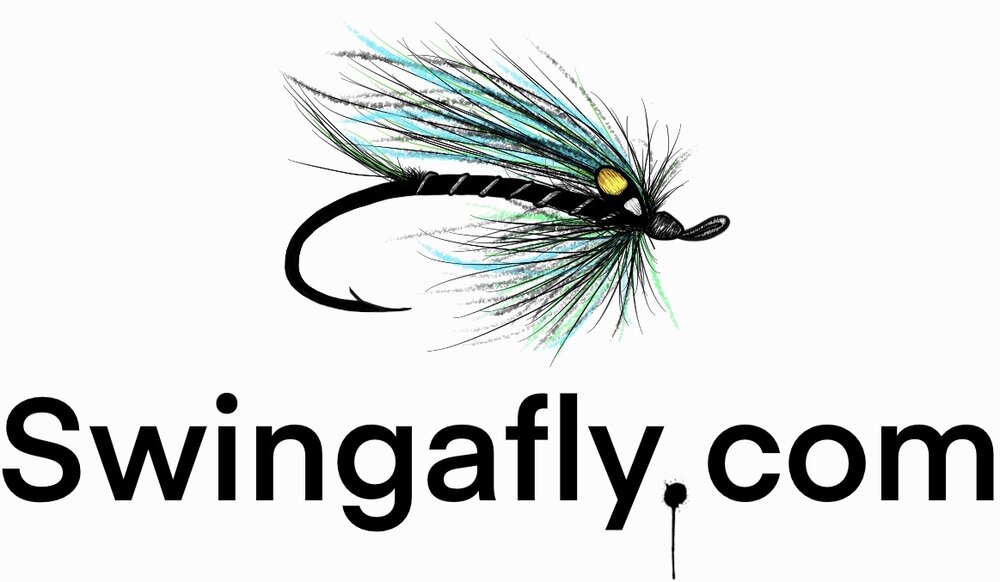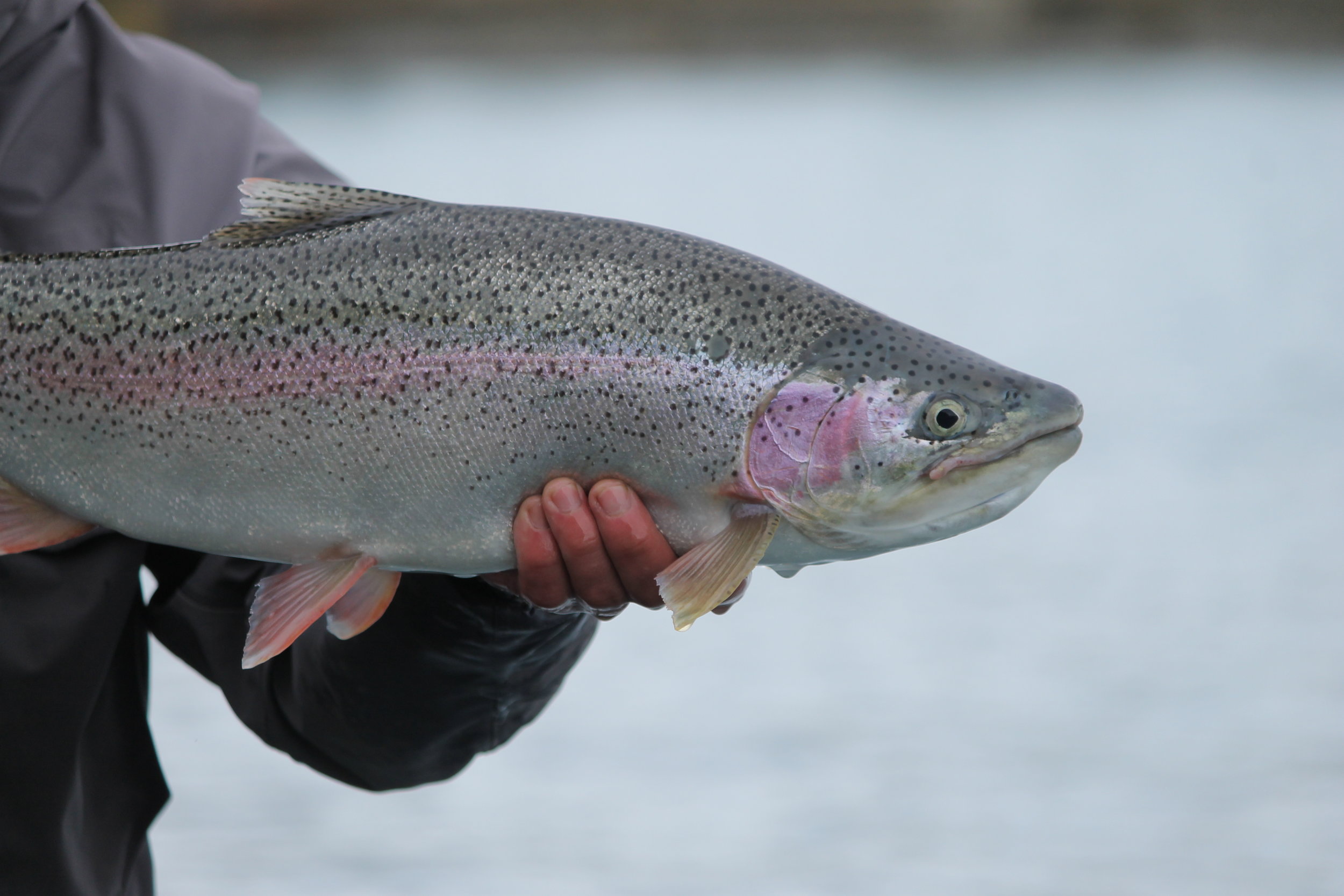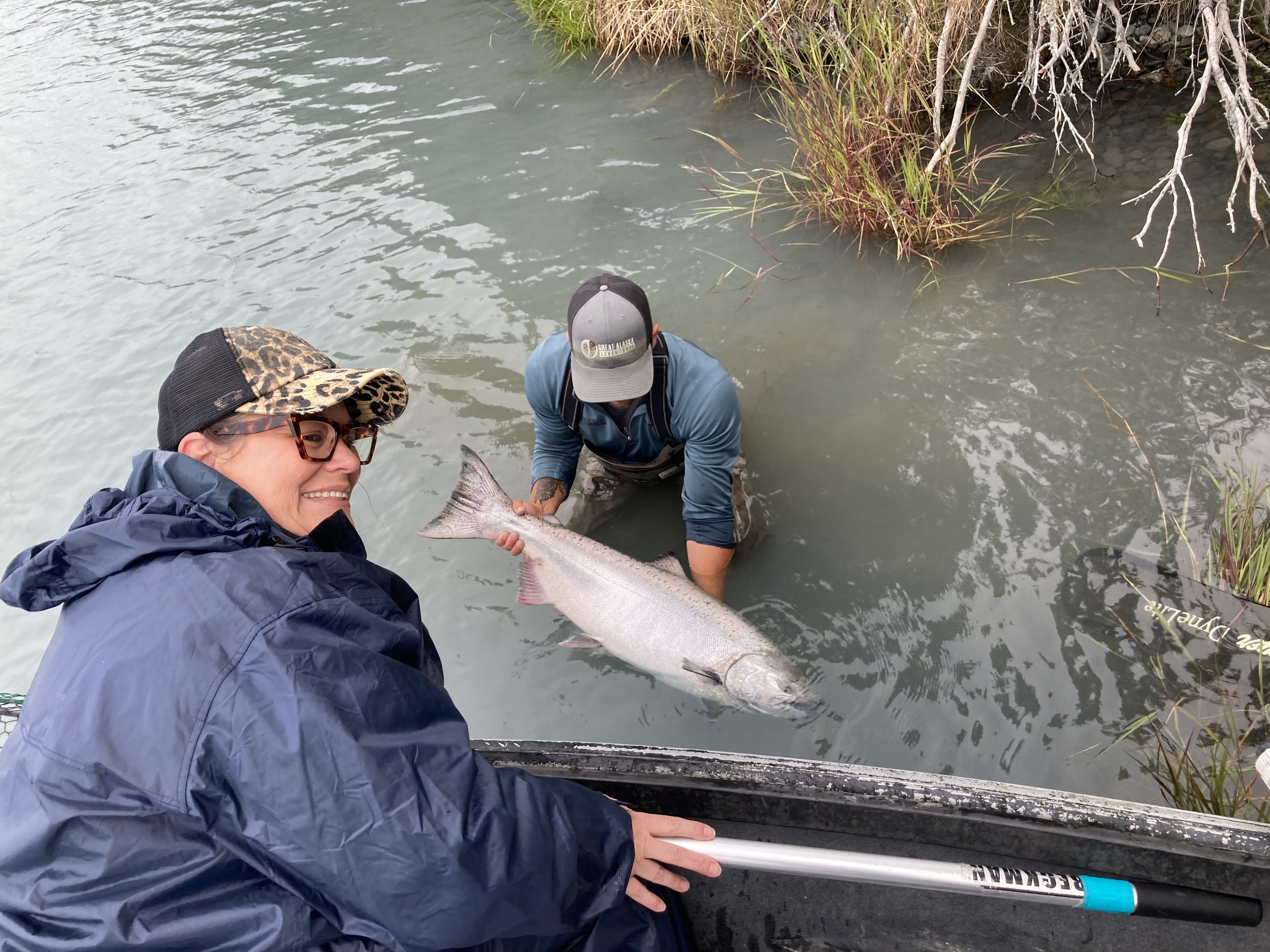Fishing the Kenai Peninsula
On May 17, 1985, Les Anderson landed the all- tackle world record king salmon from the Kenai River in Alaska. Weighing an incredible 97 pounds 4 ounces, this fish was about 5 feet long and had a 37.5 inch girth. From then on, the Kenai River salmon fishing was on the map. The guide and tourism industry officially kicked off and has been growing ever since. The Kenai is now one of the most popular sport fishing rivers in the world. Both the Kenai and Kasilof rivers get runs of 4 of the 5 species of pacific salmon. King salmon, sockeye salmon, coho salmon, and pink salmon. Both rivers are glacial fed and very cold, making it incredible habitat for resident trout and returning salmon to spawn. Unlike the more remote rivers in Alaska, only accessible by float plane, the Kenai is located on the road system. This allows access to boaters, both private and guide, bank fishermen, and anyone else who wishes to enjoy its beauty and wildlife. Tourists flock by the thousands from all over the world for a chance at a record salmon or trophy rainbow trout. This can especially be true during peak sockeye season where fishermen will line the banks elbow to elbow looking for their daily limit. There are also times where you may have the river all to yourself as it gets a bit later in the season. There are also a plethora of lakes and smaller streams that also house runs of salmon and hold resident trout and even grayling. Having said that, its crucial to book your trip at the right time of the year. Knowing what you want to fish for and when is key. Understanding possible weather and river conditions that you will be experiencing. How do you like to fish? Do you prefer to fly fish or spin fish? Trout or salmon or both? These are questions we pride ourselves in asking. Setting your trip up can at times seem overwhelming with the amount of information out there. Every location has five star fishing, wildlife, and views. We encourage all potential customers to check reviews on outfitters, research what you want to fish for and when, and understand that success is always based on run timing. The run times are never exactly the same each season. Sometimes the fish are running early, late, or not at all. Salmon do not have iPhones, there are a multitude of factors that dictates each years salmon runs. Having a good attitude and reasonable expectations regarding all wildlife is the best approach. Through years of experience, we work extremely hard each day for our customers, to assure the best possible chance at your bucket list fish. Please refer to our fish calendar for run timing and continue reading below about the species we target to better understand our fishery. We look forward to fishing with you in the future and helping you arrange your trip of a lifetime!
kasilof King Salmon
May 20th - July 31st
We are not currently fishing Kenai River kings. Due to closures and dangerously low fish returns, we are only fishing the Kasilof river for kings. The Kasilof has a run of both Hatchery and Wild. The early run is the hatchery run. This is where we kickstart our season. The use of bait opens up on May 15th for King Salmon on the Kasilof river. A beautiful 17 mile glacial fed river system that is home to some incredible sized fish. While its still early in the year, this is a great time for the spey angler to get out while the water is low and slow. There’s not too much river traffic during this time as the fishing can tend be a bit slow to start. However, each year is different and salmon fishing is all about timing. Never a guarantee by any means, King salmon fishing is the toughest fishing we do. A pure numbers game, we rely heavily on good return numbers but each year is a toss up on the peninsula. As of 2023, we are allowed to retain one hatchery king salmon per day on the kasilof river. When the run of wild kings starts in July, it is catch and release only. The head of the fish is not allowed out of the water. If you are a bait fisherman, bait can open and close without much warning. The most conventional way to target these fish is a method called backtrolling. While oaring a driftboat, you slowly back down your offerings, usually bait, to these fish while waiting for your rod to get smashed. Its designed to be a relaxing day with minimal effort for the client. If you enjoy casting and working lures or flies, this may not be the trip for you. Although the most proven method, it can be a bit inactive if the fishing is not the greatest that day. We always make the most it and have a great time regardless. If you enjoy casting and would be interested spey fishing or floating bobbers for kings, we can absolutely do that as well! Remember, kings are a trophy fish and should be treated as one. A fish of a lifetime for most. We still have some of the largest king salmon in the world here and we restrict all customers from retaining a wild king salmon regardless of current harvesting restrictions. Most outfitters around the peninsula these day also encourage the same practices. If you are looking for the challenge and thrill of a lifetime, come up and take a stab at king fishing.
sockeye salmon
June 11th - August 10th
Sockeye are considered by most to be the best tasting salmon we have. No wonder why its our busiest time of the year. With the goal of most being to stock the freezer or share with family and friends, this is what we would consider to be our harvesting part of the season. Early run sockeye, which is the significantly smaller run of the two, start to trickle in to our rivers as early as the first week of June. While the return numbers on the early run aren’t nearly as high, the crowds aren’t either and it makes for a great time on the river. Usually plenty of fish to go around in June. Some days you may have to work harder than others but it makes for a good days labor. And the rewards taste great on the smoker. There is usually a small lull in between the two runs. The first week of July is historically the in between time but there are still fish around. It starts to get hot and heavy on both rivers around the middle to ladder part of July. This is when the rivers are busiest and the term combat fishing applies. The fishing can be absolutely incredible. The 2023 Kenai run was 2,351,020 fish and the Kasilof run was a respectable 932,896 fish. With plenty of fish to go around, It can be a challenge to find a good spot on the river some days but it always works out in the end. Sounds crazy but it gets crazier when I explain the technique. Sockeye are an interesting bunch. They are zooplankton eaters. (Krill, sea snails, pelagic worms, etc.) Much unlike other species which are eating herring and squid. Sockeye, just like all salmon species, have zero interest in feeding once they enter freshwater from the saltwater. However, all other species of salmon do have what is considered a reaction bite. Meaning they will take a fly, lure, or bait offering out of instinct. Usually the longer the fish are in the river, the less likely they are to bite. With Sockeye, it is completely different. They DO NOT have much of a reactionary bite if any. With that said, the most productive and popular method to catch sockeye is called flossing. Flossing is running a heavy mono leader through the fishes mouth as they swim up river using heavy lead, and a hook with some yarn added for buoyancy. Flip your rig out and the weight will tap off the bottom , while the buoyancy of your fly hangs the hook up in the water column a tad. With your leader stretched out by the weight, this allows the line to enter the open sockeye mouth as they swim upstream near the bank. The angler will feel the line stop and set the hook. You will see this technique being done up and down the riverbank. It can take a bit to get used to but I would consider this technique more harvesting than fishing. When the fish are in the river, you catch them. They swim up both sides of the riverbank right in line for eager anglers to harvest. Patience is key. Once a wave of fish starts to approach, it becomes catching at that point. Fun for the whole family. This style of fishing requires the angler to wade in the water in order to be able to have a chance. We prioritize safety on these trips and make sure is everyone is comfortable and in a safe environment. For those that have no interest in being in the water, we do offer a boat trip that would be backtrolling for sockeye. Although not always as effective as flossing, its a great alternative for those that might be immobile or for young kids. But what about the reactionary bite? Well there is one exception. Certain areas of these rivers get large bunches of salmon that stage. While they are staging, they can become quite aggressive and will take a salmon plug backtrolled. Some anglers prefer to avoid the “combat zone” and opt to go with the option of fishing from the boat. It has become more and more popular as the years go on. Either way we are always more than happy to accommodate. Please feel reach out with all your questions regarding your sockeye dreams. We are here to help!
Silver salmon
August 15th - October 31st
The last species to enter both the Kenai and Kasilof rivers, the silver salmon is everything you want in a sport fish. Aggressive, athletic, and strong. These fish allow for an array of techniques which make them suitable for all anglers and skill levels. They are also great table fare which is fantastic if you are looking to send some fish home. These fish also have two runs. An early run and a late run. The larger being the late run. The first few fish start trickling in as early as the first week of August. The early run can be hit or miss. Timing is key as always. Popular techniques include: Flies, spinners, spoons, Maglips, kwikfish, bobber and eggs, twitching jigs, and large soft beads under a float. The list can go on. Unlike Sockeye, these fish have an incredible reactionary bite and will strike at many different styles of offerings. Although some techniques work better than the others at different times during the season, we like to cater to what’s comfortable for the customer and how they like to fish. The early run fish tend to average between 5 - 10 pounds while the late run fish run a bit larger and average 8 pounds upwards to potentially 20 pounds. Silvers are a very acrobatic fish as well. Cartwheeling out of the water and going on blistering runs. These fish tend to be the favorite target species for most Alaskan anglers. There is plenty of water to fish between both the Kenai and Kasilof rivers. As the second run of fish gets going, the temps usually start to drop along with the water levels. The layers and heaters usually start to come out heavy during this time of year. Especially in the early mornings. The low water makes for a great opportunity for the fly angler. Potentially having the chance to sight fish these brutes. Silvers are known to take flies very well. And we love to see it! If casting a fly rod isn’t an option. Conventional tackle works just fine. A slip bobber and some freshly cured eggs can be loads of fun in the back channels of the Kenai river. As always, please feel free to reach out with any questions or for more information on these special fish. We would love to help you connect on a trophy Coho in the future.
rainbow trout and dolly varden
June 11th - October 31st
Alaska has some of the largest rainbow trout in the world. Largely due to their diet, the rainbows and dolly varden feast on salmon flesh and eggs and grow to enormous size and length. Alaska’s trout fishery is unlike any other trout fishery in the world. Something any trout angler needs to experience at least once in their lifetime. The Kenai is where we do the majority of our trout fishing. It’s cold glacial water provides excellent habitat for these fish. The dolly varden in the Kenai are both resident and sea run. Whereas our rainbow trout are all resident with some steelhead mixed in. Each year, Alaska fish and game closes the Kenai to all trout fishing from May 1st thru June 11th. June 11th is our trout opener and is when we can start legally targeting them again. Washed out flesh patterns, beads, nymphs, dry flies. Usually around the opener can be pretty good each year as long as you make it a point to avoid fishing around any remaining spawning fish. Otherwise, as the weeks go on into the summer, trout fishing in Alaska remains as good as anywhere else in the world. Epic days. Slower days. You just never know. It isn’t until the middle to late August time frame when things start really heating up. At that time, all the salmon are in the river and starting to drop their eggs. The kings will drop first. Fishing is all downhill from there as the remaining salmon species will soon follow suit. Both rainbows and dollies will key in on these eggs and it leads to some of the most incredible fishing you can imagine. Lots of action, lots of fish. Unforgettable days. These fish are very fly rod friendly. Spin gear is also a popular method as well. Either way we got it covered. As the season continues on through September and October, the trout are still aggressively feeding knowing that the food supply will be minimized soon. These are the times were a lot of big trophy fish are caught. They are in peak physical condition and are a little more eager to make a mistake as the season wains on. Multiple fish over 30” are landed every year. True giants! We love fishing and talking trout. We cater to the serious and casual trout anglers. The beauty with these fish is that they are always around to catch. Unlike salmon that migrate. This make our trout fishing a great activity for the whole family. If you would like more information on our trout fishery, please contact me and I would be happy to talk trout with you!
steelhead
September 1st - October 31st
Steelhead are considered the gentleman’s fish. A fish of a thousands casts, these fish boast big time power and athletic ability. A true sportfish. Typically not a trip for the casual angler. Expectations are never high on a steelhead trip and some folks are not okay with that. Run timing is everything. Each year can be a bit different. If timed right, the steelhead fishing on the peninsula can be incredible. Typically, we start to take clients on the upper Kasilof river for steelhead right around the first week of September. The run gets stronger as the month goes on but catching it early can be pretty amazing. These trips are fly fishing only and we practice catch and release with all wild steelhead. We cater to both spey fishing or indicator fishing. Both techniques work very well. The upper Kasilof is a very peaceful and beautiful float. I would describe the river as very pleasurable to fish. Easy wading, gorgeous runs to swing. The fish can be anywhere from 5 to 20 pounds and larger. With the Kasilof river being the shorter of the two rivers, these fish stay pretty hot and energetic throughout the system. Nothing like a big broad side smash from a sea-liced steelhead! The Kasilof is big enough for a full length spey rod and fits best with a 10’ 7wt if you are bead fishing. There are some smaller streams to walk/wade for steelhead around the peninsula where a single hand spey would be appropriate as well. Temps can tend to drop during steelhead season so bringing the proper layers is crucial for your visit. All of the fishing will be out of the boat so its best to come prepared with plenty of warm gear for this trip. Are you tough enough to take on some Alaskan steelhead. Feel free to give us a shout and we would love to help you find out!
The braggin’ board
2017 - 2023














































